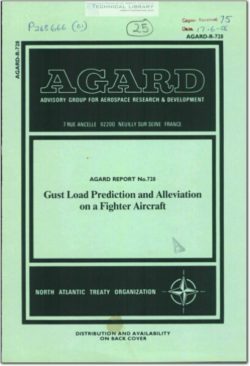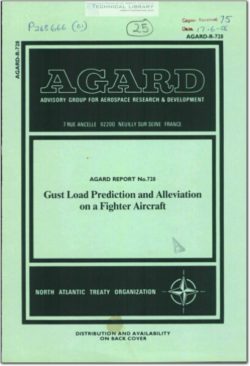AGARD-R-728

- Version
- 180 Downloads
- 3.02 MB File Size
- 1 File Count
- April 25, 2016 Create Date
- April 25, 2016 Last Updated
Gust Load Prediction and Alleviation on a Fighter Aircraft

Turbulence induced dynamic loads and vibrations on a fighter aircraft may play a
considerable role for certain configurations with respect to the design of the structure
and the performance of special missions or they may cause on the other hand limitations
of the flight envelope.
As far as aircombat aircraft are concerned typical restrictions may be found for
instance with respect to design gust loads if wing tip mounted store configurations are
investigated or with respect to ride comfort if low level high speed missions are evalua-
ted. Here both aspects namely design gust critical cases and ride comfort are therefore
reported in more detail in order to demonstrate-the problem areas. In this context also
some difficulties of turbulence response prediction methods will be described, especially
with respect to the dynamics of the aircraft with FCS and the interaction of flight
and structural dynamics, though these,methods are well established. In addition problem
areas of the aircraft with FCS and gust alleviation system are mentioned for the case
of ride improvement. The design of such systems would strongly necessitate the full dyna-
mic description of the flexible fighter aircraft in order to evaluate maximum loads, fati-
gue loads and structural coupling problems with the control system.
The following problem areas may be of importance for the aircraft with JCS and for
dynamic load alleviation and ride improvement systems. During the development of a system
for the proper achievement of ride smooting, as for instance based on the requirements as
specified in MIL-F-9490 D (USAF) chapter 3.1.2.12, or for the purpose of gust load alle-
viation (MIL—A-8861 requirements) of course the controlled aircraft must be investigated.
The solution of the nonlinear flight dynamic equations of motion of the aircraft
with flight control system dynamic equations together with structural dynamic
equations in time domain.
The solution of linearised flight dynamic equations of motion of the aircraft with
coupled structural dynamic equations in frequency and in time domain.
The calculation of the dynamic response in time domain using a) includes the simu-
lation of nonlinear effects at severe disturbance conditions, as for example aero-
dynamic nonlinearities (which are included in the static aerodynamic data set),
rate and deflection limitations of the control surfaces due to marginal actuator
power and inertia coupling at high rates.
| File | Action |
|---|---|
| AGARD-R-728 Gust Load Prediction and Alleviation on a Fighter Aircraft.pdf | Download |

Comment On This Post